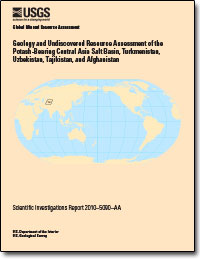Geology and undiscovered resource assessment of the potash-bearing Central Asia Salt Basin, Turkmenistan, Uzbekistan, Tajikistan, and Afghanistan: Chapter AA in Global mineral resource assessment
Links
- Document: Report (7.8 MB pdf)
- Larger Work: This publication is Chapter AA of Global mineral resource assessment
- Spatial Data: GIS Data (4.1 MB zip)
- Download citation as: RIS | Dublin Core
Abstract
Undiscovered potash resources in the Central Asia Salt Basin (CASB) of Turkmenistan, Uzbekistan, Tajikistan, and Afghanistan were assessed as part of a global mineral resource assessment led by the U.S. Geological Survey. The term “potash” refers to potassium-bearing, water-soluble salts derived from evaporite basins, where seawater dried up and precipitated various salt compounds; the word for the element “potassium” is derived from potash. Potash is produced worldwide at amounts exceeding 30 million metric tons per year, mostly for use in fertilizers. The term “potash” is used by industry to refer to potassium chloride, as well as potassium in sulfate, nitrate, and oxide forms. For the purposes of this assessment, the term “potash” refers to potassium ores and minerals and potash ore grades. Resource and production values are usually expressed by industry in terms of K2O (potassium oxide) or muriate of potash (KCl, potassium chloride).
The CASB hosts significant discovered potash resources and originated in an inland sea during Late Jurassic time. Seawater flowed into the CASB, mostly from its extreme northwestern margin near the modern Caspian Sea, during several evaporation episodes that deposited at least five different packages of evaporites, with virtually all potash in the second and fourth packages. In this study, the CASB was subdivided into three tracts (permissive areas) for evaluation: the Amu Darya tract in the west, the Gissar tract in the center, and the Afghan-Tajik tract in the east. The Gissar and Amu Darya tracts were quantitatively assessed, whereas the Afghan‑Tajik tract was only qualitatively assessed because of the commonly extreme depth (as deep as 7 km) of the Jurassic salt, extensive deformation, and a lack of known potash deposits.
Two approaches were used to estimate amounts of undiscovered potash in the CASB. Stratabound evaporite deposits in the Amu Darya tract were evaluated using an Adaptive Geometric Estimation (AGE) approach, which estimates in-place potash volumes and tonnages. The Gissar tract was evaluated by using the AGE approach for stratabound deposits and the three-part form of assessment of Singer and Menzie (2005) for discrete halokinetic deposits. In the three-part form of assessment, numbers of undiscovered deposits were estimated and combined with grade and tonnage models to probabilistically forecast the amount of undiscovered potash. The Amu Darya tract is estimated to contain 38 billion metric tons of undiscovered potash as K2O by using the AGE approach for stratabound deposits. The hybrid stratabound-halokinetic Gissar tract is estimated to contain between 1 and 16 billion metric tons of undiscovered potash as K2O.
Chapter 1 of this report provides an overview of the history of the CASB and summarizes evaporite potash deposition, halokinesis, and dissolution processes that have affected the current distribution of potash-bearing salt in the CASB. Chapter 2 describes the Gissar tract, an uplifted region that contains a mix of stratabound and halokinetic potash deposits and all of the discovered and exploited potash deposits of the CASB. Chapter 3 describes the Amu Darya tract, where evaporite deposits remain flat-lying and undeformed since their original deposition. Chapter 4 describes the highly deformed and compressed Afghan-Tajik tract and what is known of the deeply-buried Jurassic salt. Chapter 5 describes the spatial databases included with this report, which contain a collection of CASB potash information. Appendixes A and B summarize descriptive models for stratabound and halokinetic potash-bearing salt deposits, respectively. Appendix C summarizes the AGE method used to evaluate the Gissar and Amu Darya tracts. Appendixes D and E contain grade and thickness data for the Gissar and Amu Darya tracts. Appendix F provides the SYSTAT script used to estimate undiscovered K2 O in a CASB tract. Appendix G provides a potash glossary, and appendix H provides biographies of assessment participants.
Suggested Citation
Wynn, Jeff, Orris, G.J., Dunlap, Pamela, Cocker, M.D., and Bliss, J.D., 2016, Geology and undiscovered resource assessment of the potash-bearing Central Asia Salt Basin, Turkmenistan, Uzbekistan, Tajikistan, and Afghanistan: U.S. Geological Survey Scientific Investigations Report SIR 2010–5090–AA, 106 p., and spatial data, https://dx.doi.org/10.3133/sir20105090AA.
ISSN: 2328-0328 (online)
Study Area
Table of Contents
- Abstract
- Chapter 1. Overview of the Geology and Assessment of Undiscovered Potash Resources in the Central Asia Salt Basin, Turkmenistan, Uzbekistan, Tajikistan, and Afghanistan
- Chapter 2. Potash-Bearing Salt Assessment for the Gissar Tract (142mxK0005a)—Turkmenistan, Uzbekistan, Tajikistan, and Afghanistan
- Chapter 3. Stratabound Potash-Bearing Salt Assessment for the Amu Darya Tract (142sbK0005b)—Turkmenistan and Uzbekistan
- Chapter 4. Potash-Bearing Salt Assessment for the Afghan-Tajik Tract (142haK0005c)— Uzbekistan, Tajikistan, and Afghanistan
- Chapter 5. Spatial Databases for Resource Assessments
- References Cited
- Additional References
- Appendix A-H
| Publication type | Report |
|---|---|
| Publication Subtype | USGS Numbered Series |
| Title | Geology and undiscovered resource assessment of the potash-bearing Central Asia Salt Basin, Turkmenistan, Uzbekistan, Tajikistan, and Afghanistan: Chapter AA in Global mineral resource assessment |
| Series title | Scientific Investigations Report |
| Series number | 2010-5090 |
| Chapter | AA |
| DOI | 10.3133/sir20105090AA |
| Publication Date | March 23, 2016 |
| Year Published | 2016 |
| Language | English |
| Publisher | U.S. Geological Survey |
| Publisher location | Reston, VA |
| Contributing office(s) | Geology, Minerals, Energy, and Geophysics Science Center |
| Description | Report: xi, 106 p.; GIS Data |
| Larger Work Type | Report |
| Larger Work Subtype | USGS Numbered Series |
| Larger Work Title | Global mineral resource assessment (Scientific Investigations Report 2010-5090) |
| Country | Afghanistan, Tajikistan, Turkmenistan, Uzbekistan |
| Online Only (Y/N) | Y |
| Additional Online Files (Y/N) | Y |


